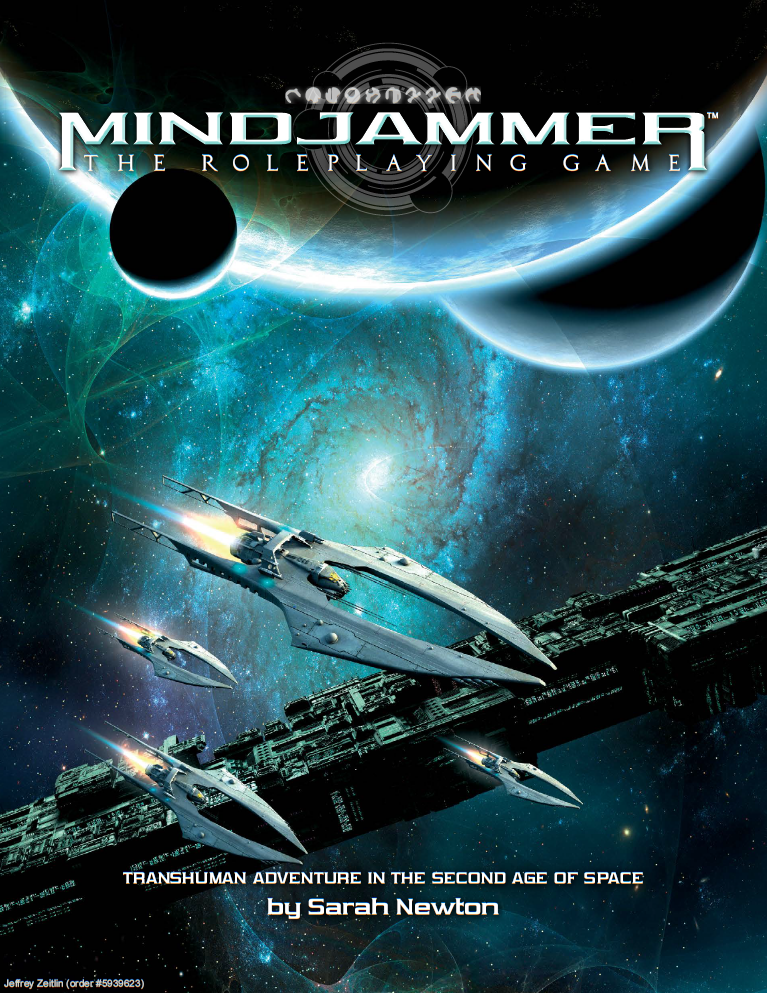Mindjammer: The Roleplaying Game
This article originally appeared in the June/July 2014 issue.
 Mindjammer:
The Roleplaying Game. Sarah Newton.
Mindjammer:
The Roleplaying Game. Sarah Newton.
Mindjammer Press http://www.mindjammerpress.com
496pp, hardbound or PDF
US$54.99 (Print+PDF bundle)/US$27.99 (PDF only)
Disclosure: A complimentary copy of the PDF edition was made available to the author for the purpose of review.
Like Diaspora and Starblazer Adventures, previously reviewed in Freelance Traveller, Mindjammer is based on the FATE system. It represents a third esthetic for FATE-based SFRPGs, lying somewhere between the rollicking comic space opera of Starblazer Adventures and the very Traveller-like crunch of Diaspora.
The FATE system is very strongly narrativist, so the emphasis is on role-playing, with simple mechanics and little of the bookkeeping that characterizes most versions of Traveller as written. It has been discussed in Freelance Traveller’s prior reviews of Starblazer Adventures (reviewed by “kafka”, October 2010) and Diaspora (reviewed by Jeff Zeitlin, February 2011), and so will not be discussed here; rather, the focus will be on the setting.
Transhumanism has not been a significant part of Traveller, though Mongoose Traveller does allow for some possibilities outside of the Third Imperium setting. Mindjammer, however, is a strongly transhumanist setting, and offers a significant degree of modularity, to allow elements of the setting to be transplanted to other games, or to be included or omitted as desired in a Mindjammer game. Rules for creating various aspects of the setting are detailed enough to satisfy even hard-core “gearheads” of all types, but where gearheading is unnecessary or undesirable, a few broad strokes of FATE Aspects can be enough to satisfy the needs of the game.
Character types, including various humans, both genetically modified and not, uplifted animals (“Xenomorphs”), artificials (including such things as sentient starships, space stations, and so on), and aliens, are available to players, each defined by various combinations of Aspects, Flaws, and Extras. Further definition of characters is defined by additional Aspects, Skills, Stunts, and so on of Careers. While a wide range of sample careers and character types are presented, instructions for creating your own follow the examples. There is even a chapter on organizations in the Mindjammer setting, with rules and templates for creating your own.
While the distinction between the ‘real world’ and ‘virtual reality’ continues to exist in Mindjammer, the line between them begins to blur with the Mindscape and an individual’s ‘halo’. The halo is described as an individual’s extension into the Mindscape (through a Mindscape implant), and that extension enables the use of certain skills, enhancements, extras, and so on. Many of the skills provide analogues to “classic” psionic powers such as telepathy, psionic assault, and perception. Beyond that, virtual realities can be as convincing as the real world, and what happens in the Mindscape can have real-world consequences. The speed of light is still a limit for data transmission, so the Mindscape is kept approximately synchronized between worlds through starships carrying updates.
An in-depth look at the sociopolitical structure of the setting is presented, outlining polities, corporations, cultures, and technology, fitting them together and providing rules for using them in the game, and (as usual) creating your own. Extensive rules for world-building (and star system building) are included, as well, and potentially offer a greater range of environments than stock Traveller. It is even possible to define ecosystems ranging from artificial (for food production) through transplanted Terrestrial biota to habitable-but-incompatible and completely alien.
One resource that Mindjammer provides in the core book that Traveller to date lacks is a guide to creating scenarios and campaigns. Obviously, it focuses on (and provides examples using) the standard Mindjammer setting and the FATE system, but the linkage is not strong, and the two chapters that comprise the guide would be a useful resource for any system.
Mindjammer is not Traveller, but this book is worth using as a resource for ideas that can be incorporated into Traveller, even if you don’t want the high level of Transhumanism that its setting assumes.
 Freelance
Traveller
Freelance
Traveller